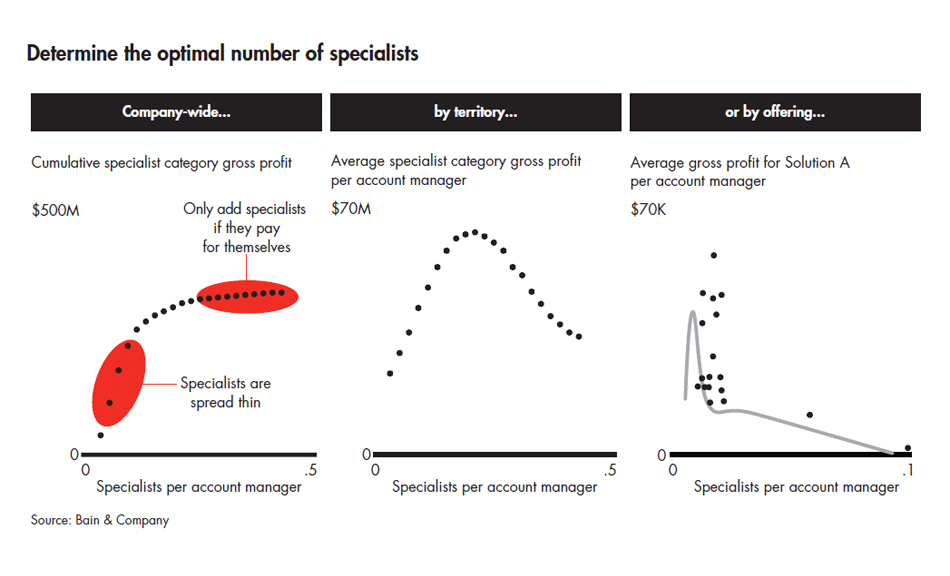Brief
For decades, scale economies ran like clockwork in the world of sales. Companies in business-to-business (B2B) markets consistently grew their revenues faster than their sales and marketing expenses. But for nearly 12 years, that trend has stalled and in some cases reversed. The sales models for many large companies have become more complex and less efficient, putting pressure on profit margins.
How big is the problem? Bain & Company analyzed the 2003–2011 income statements of roughly 200 large US-based companies in healthcare, technology and financial services. More than half of these companies had increasing sales and marketing expenses as a percentage of revenues over the period, or they failed to demonstrate the scale benefits that one would expect from their growing size.
 |
In our experience, a few key factors account for this reversal, starting with how the shape of demand has changed in many industries:
• Customer needs have grown more sophisticated. Buyers increasingly demand a tailored solution anchored in expertise about their industry or a specific function. In software and business process outsourcing, for instance, spending on vertical industry offerings will grow twice as fast as general enterprise software spending through 2015, Gartner estimates.
• Customers expect providers to help solve their business problems and measure value based on outcomes, not necessarily the lowest price. Medical device firms that previously sold stents and defibrillators now are being asked by customers to improve patients’ health outcomes. Sellers of oil and gas are being asked to reduce customers’ energy footprint.
• Customers have become more experienced with competitive, disciplined bid processes. Buyers can readily gather basic information about products Then, in the vendor selection stage, total cost of ownership and return on investment trump relationships. Purchase decisions that were previously controlled by one manager now involve a web of stakeholders. As a result of these shifts, the day of the pure generalist relationship manager is over.
• Customers are less loyal because they’re wary of being locked into a vendor’s products. Customer loyalty has become increasingly important to a supplier’s long-term health. Sales performance thus depends on the ability to retain high-value customers, to up-sell at the point of sale and to expand the customer relationship through cross-selling.
In turn, these shifts in demand have caused companies to dramatically change what they sell. First, offerings have shifted from single-product to multi-product portfolios, with the products ranging from cutting-edge to mature. Second, product-based sales have been supplemented or replaced by sales of solutions that knit together disparate products or services into an integrated offering. Finally, transactional selling based on knowledge of product features, functionality and cost has become less relevant than consultative selling that’s tailored to the customer’s industry or business situation and must meet a customer’s threshold for return on investment.
Simply put, most current sales models are not keeping pace with the shifts in demand, as many companies struggle with factors that contribute to higher costs. Account managers may realize too late that they need additional expertise, and they frantically call specialists to join a sales effort at the last minute. In other cases, companies deploy specialists before thorough qualification of a prospect, or to help with contract negotiations. Each situation results in overused, misapplied sales resources or missed business opportunities. Companies also are finding they have loaded up on variants of solutions, sales teams and sales coverage—a creeping complexity that raises costs and ironically can stifle the growth that an expanded offering set is intended to provide.
Achieving growth targets profitably requires a repeatable, high-return model for selling solutions. And that means knowing where and how to invest in sales resources. Bain recently surveyed senior sales and marketing executives in 24 B2B companies, and found that 15% more high-performing companies than low-performing companies had built a differentiated capability to deploy their selling resources to the highest-value market opportunities. (Performance was measured by customer loyalty scores relative to competitors and five-year relative market share trends.)
For some leading companies that have started to overhaul their sales models, the upside is equally dramatic, setting them up to once again grow revenues faster than expenses. That’s especially valuable for companies operating in the current low-growth economies of many developed countries. By contrast, companies that do little to rethink their model will be saddled with a larger, cumbersome sales organization that not only erodes margins, but worse, misses the biggest opportunities with high-value customers.
The center of gravity moves from generalist to specialist
For much of the 20th century, when companies had a series of individual product lines, their sales model could thrive as long as they had the right account coverage, focused to some degree on key accounts, with a crisp pitch on features and functionality. Today, what’s required is assembling the right team of experts with relevant solution knowledge at the right time (no more, no less) in the sales cycle. In the face of new demand characteristics, successful sales organizations will provide a tailored experience for the customer, but through an efficient, scalable model.
Some complexity is unavoidable, of course, yet poorly managed complexity can erode customer confidence. We recently sat in on a technology provider’s sales call with the CIO of a prospective customer, during which several product engineering specialists debated how to configure a solution. Prior to the key meeting, no one had led a process to sort out the different expert points of view so that the supplier could present a coherent case. The CIO was not impressed.
In this evolving environment, the skills of the account manager need substantial upgrading. There’s still a need for some oversight skills, but even senior customer relationship executives (CREs) now are expected to be experts in some of their company’s offerings. That helps limit the cost of an expanding specialist bench and secure the CRE’s credibility with customers.
Credibility, in particular, is an essential quality for selling solutions or consultative offerings. At most large B2B companies, no single person can credibly sell the full portfolio. Sales organizations need to bring on board people with targeted expertise or new types of skills, including proficiency in consultative sales. The skill gap rarely can be closed through training alone; new people inevitably need to be hired. When B2B companies undertake a sales model transformation from single-product to multi-product or solution sales, they typically experience a 40% to 60% turnover of generalists, or individual product sellers, over two to three years.
Building a new sales regime
Restructuring a sales model for these new realities does require substantial effort and time—but it’s no longer optional. And the transformation will not happen overnight, though it can be designed to rapidly stage the change. In our experience, four mutually reinforcing actions can help senior executives keep on track with greater certainty and pace.
1. Identify customer sweet spots and define the appropriate offering, then put a repeatable process in place to expand to other segments.
Leading sales organizations figure out exactly which products and solutions they should sell to which core customers and how to adapt the offerings efficiently for other customer segments. They devise a repeatable model that can be applied to existing customers with new products, or to sell existing products to adjacent segments such as other industries or geographies.
Suppliers can identify the sweet spots for investment by using two criteria: segments with the most attractive lifetime economics and those where a company’s distinctive offerings win consistently.
Infor, a US-based firm that sells software solutions mostly to small businesses, exemplifies this approach. Infor identified roughly 2,000 micro-verticals, such as brewers and hospitals, where it had more specific and relevant offerings than competitors did. Businesses in these micro-verticals have processes that are critical for success in their focused market, such as shelf-life management in organic farming and nurse scheduling in hospitals. Infor tailors its solutions for the micro-verticals, bringing to bear its expertise in the specific processes. By identifying standard building blocks of functionality that can be readily adapted for different geographies or micro-verticals, Infor has created a repeatable process.
For example, process software for a brewer in Germany can be applied with only slight customization to a juice maker in the US or a soda maker in Mexico. This creates a lot of value, because customers don’t have to build and integrate a solution themselves, customize a generic offering or settle for a substandard alternative. One specialist in liquid processes can sell to all three types of customer, in combination with a generalist in each country who understands the regional issues involved. Over time, Infor develops the in-country capacity to support demand through direct, indirect or telesales support.
This scalable approach to segment expansion has allowed Infor to increase its market share in sweet-spot segments and win more business with larger enterprises.
An effective way to identify sweet spots for target segments is to map the potential choices along a spectrum of solution types, each of which can influence the go-to-market model (see Figure 1). The exercise involves defining the nature of the solution, the target decision maker, the sales cycle and the implementation team required.
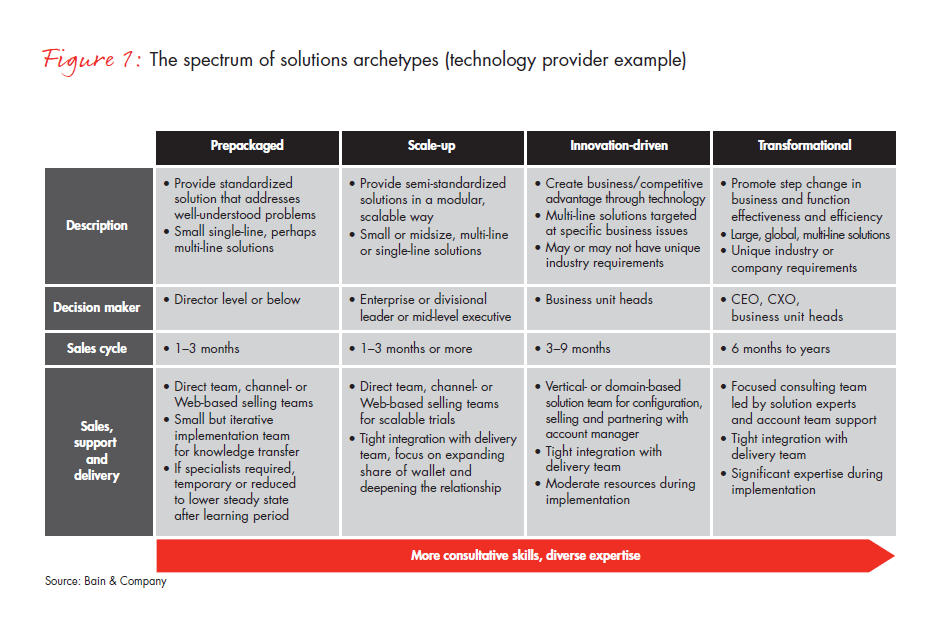
At the far left of the spectrum is a single-product or multi-product line, no longer positioned as feature or functionality, but as an answer to a business problem—for example, a computer sold to manage the customer’s asset base. The problem is typically well understood, and the solution and deployment are clear. Next are multi-product or service solutions that may require some tuning to a specific situation, but can be scaled up and repeated across a large group of salespeople, with some specialization. These are the foundations of building a high-volume, scalable solution business.
At the far right, transformational solutions can lead to significant brand equity and customer loyalty, but take longer to sell and require more integration with the delivery team. These are often larger deals that have less scalability and a more complicated sales process than pre-packaged solutions.
At any point along the spectrum, smarter segmentation benefits B2B companies. For a European directory company, better segmentation came from taking its database of invoiced revenue from customers, layering on customers’ total advertising spending and modeling the handful of characteristics that explained buying behavior. These turned out to be type of business, size and the degree to which customer locations were urban or rural. That allowed the directory company to sort its customers by their development potential, and then select the appropriate mix of channels and the right sales offering for each segment.
Another way to glean or refine your sweet spot is to listen closely to customer feedback. That’s exactly what Hess did in its energy marketing business in the US. As energy deregulation continues and customers increasingly want help managing their energy consumption, Hess decided to expand its solutions and further differentiate its offerings. It recently began to adapt its go-to-market approach. Hess added a new group of specialists to help customers focus on better management of their entire energy system, including economical sourcing for oil, gas or electricity from Hess. Formal customer research combined with informal feedback during the sales process allowed Hess to identify customers that put a high value on the company’s market insights.
The company now tailors the frequency and type of interaction by segment. For instance, customers that use Hess’s market insights on energy commodities receive regular electronic publications. Customers showing the greatest demand for Hess’s full portfolio of offerings—and that have the greatest potential lifetime value—receive more frequent, in-person visits.
2. Get the right people and channel—no more, no less—in front of the customer at the right time.
It’s not enough to upgrade the salesforce by hiring people with the skills and capabilities to sell solutions to target industries. Companies also find they must restructure their coverage model, which means defining and synchronizing sales roles differently. There are several key coverage questions to address, including how much hunting vs. mining capacity to employ; what the role of sales specialists should be; whether to use one or multiple salesforces to serve a segment; and whether to use one or multiple sales teams to serve a customer across different geographies.
When to hunt for new customers and when to mine deeper within current customers is one of the basic coverage choices that needs to be made explicit. CREs often get comfortable serving their current customers, so an obvious initial step is to charge them with becoming more aggressive about mining the largest customers to their full potential. At the same time, however, there’s limited growth over the long term from relying too heavily on existing customers.
That’s why an effective coverage model needs to be deliberate about who should be hunting and where. Field sales managers should meet regularly with hunting sales representatives to understand and actively refine their target prospects and break-in plan. Given the degree of difficulty and the strategic value of adding a new target customer, sellers should receive a compensation premium for breaking into new accounts.
Whether hunting or mining, it’s critical to get the mix and sequence of specialists right. Too few may jeopardize a sale because there’s no expert available to cover an area the customer considers crucial. Too many may make the cost of the sales effort uneconomic relative to the revenues accrued. (See below, “What’s a specialist worth? Here’s how to calculate the economics.”)
A CRE typically will be on point to find the right specialists who possess solid knowledge of the target’s business problems, and bring them into the sales effort when their participation will be most effective. The CRE also should orchestrate effective teaming. Like musicians who seamlessly improvise back and forth after they’ve played together several times, salespeople who get to know and trust one another tend to sell together more effectively.
There’s another imperative for teaming. Some special areas of knowledge need to become common knowledge over time in order to improve the economics of the selling model. Investment in specialists thus should be “perishable” as a solution moves through its life cycle: Deploy specialists early in the cycle to gain a foothold, and expand to build expertise ahead of the competition. Once sales increase, make sure the CRE learns the basics from the specialists in order to independently generate and qualify leads. When sales have ramped up sufficiently, reserve use of specialists only for the biggest, most complex deals, and redeploy them to other potential high-growth areas that are at the early stage of the cycle (see Figure 2).
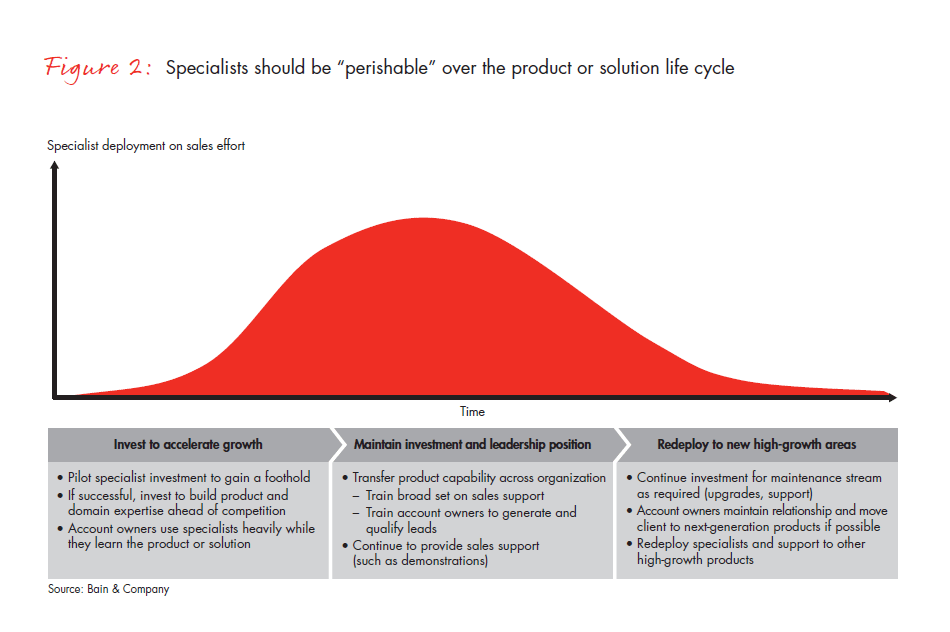
AutoTrader, a US media and software solutions provider to automotive dealers, confronted a complex portfolio and myriad go-to-market organizations after making four acquisitions in two years. It wanted to integrate these disparate sales models without disrupting customer relationships, and in a way that would encourage more cross-selling and up-selling.
To get the balance of hunting and mining right, AutoTrader designed a new segmentation scheme of acquire, develop or retain based on a dealer’s size and the company’s current share of the dealer’s spending. Now, rather than spreading sales resources evenly across accounts in a territory, resources line up better with high-potential accounts in the three segments. Smaller dealers were moved to an inside sales and service center. Territories were rebuilt so field sales reps could spend their time on accounts with the greatest retention, up-sell and cross-sell opportunities.
To boost productivity, AutoTrader realigned the specialist roles for some mature products and began to move administrative functions from the generalist account managers to the inside service team so that they could generate leads across a broader portfolio. At the same time, the company added specialist roles for complementary products in the software portfolio such as CRM.
As the new sales model is being rolled out across 23 regions in the US, early results appear promising. Small dealers are getting better service, so there’s less defection among them. The cross-selling pipeline is growing, account planning across the generalists and specialists is working well, and accountability for acquire customers is being sharpened to raise acquisition rates.
Another key coverage decision involves whether to deploy a single salesforce selling all offerings to all customers or multiple teams focused on the same customers within a segment. This will depend on the degree of buyer overlap within the customer, as well as the complexity of the company’s offering (see Figure 3).
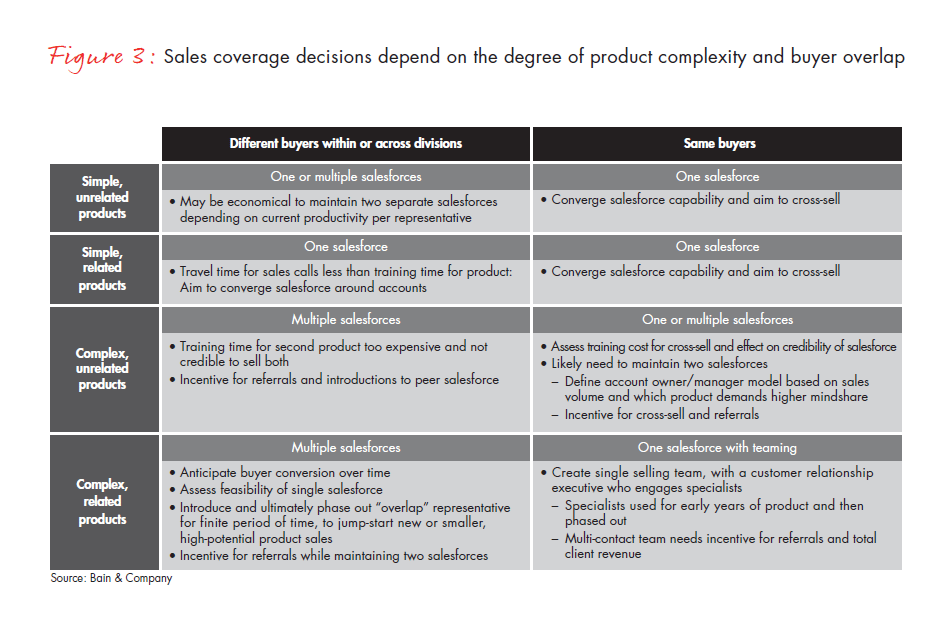
Consider one salesforce covering different customer segments. VWR International, a global laboratory supplier and distributor, decided to intensify sales efforts on faster-growing segments such as life sciences, education and medical research. VWR also wanted to meet growing demand for customized capabilities. The company reorganized sales and marketing around four customer segments, each with different needs and behaviors, and created clear boundaries between the four dedicated teams and territories.
Each current and potential customer maps to one segment, to ensure clear account ownership. Field account executives, specialists, inside sales and customer support teams also map to one segment, with a supporting generalist pool to serve small, opportunistic customers. The executive leading each segment team gets measured based on a segment-level P&L. Since implementing these changes, VWR has accelerated its revenue growth above the overall market.
Sometimes, a company should use two salesforces to reach different buyers within the same customer. For instance, one industrial company offers outsourcing services to manufacturing plant operators and other services to CFOs. The company explored combining sales efforts, but found that the offerings were too distinct and that each required extensive special knowledge. Instead, the most effective synergy arose from having the sales teams share their intelligence about the organization and its decision-making process across the salesforces informally.
Managing coverage across multiple geographies presents its own set of issues. In many cases, geographically focused sales teams for the same global customer is the most effective structure to maintain local accountability and capitalize on regional buying preferences. Typically, however, the largest or highest-potential accounts warrant global coordination. A global account manager or even a global account team may be necessary to ensure that the company encourages allies within the customer to promote the company across regions and that the sales efforts focus on the right offerings for the region.
Global coordination does not come naturally, so the business needs to orchestrate explicit decision roles and processes around pricing, post-sales support and resource allocation. One technology provider clarified roles in decision making around quotas for the most valuable global accounts (see Figure 4). This liberated the energy that had previously been consumed on cross-regional resource negotiations, and it improved information sharing and account planning.
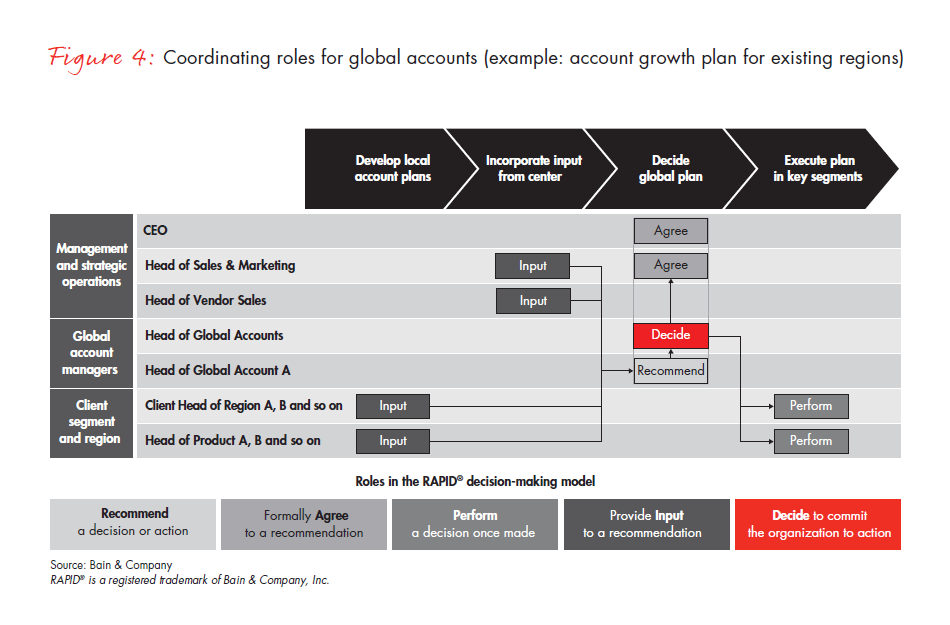
3. Design compensation to promote behaviors that support your business goals.
To raise productivity and control costs, it’s essential that everyone in the sales organization focus on attaining well-defined business goals and growth targets. The compensation system should be designed in a way that directs people to deliver on specific goals, whether that is penetrating new markets, winning new customers, cross-selling to existing customers or improving the profitability of each deal through higher pricing. Incentives should motivate individuals to reach these goals rather than falling back on traditional measures such as “last year plus 10%,” which will likely be too large or too small an increase.
One food company, for instance, was realizing lower prices than its competitors in part because salespeople were measured strictly by their sales volume, with a bonus for their tenure. By changing the performance metric to give equal weight to volume and maximizing price, the company moved prices in two years from being slightly below market to almost 2% above. That move alone yielded a $50 million increase in pre-tax earnings.
A compensation system should be flexible enough to reward excellent performance yet simple enough to be well understood and elicit the desired behaviors. The former can be done by increasing the range of compensation target earnings between top and bottom performers; the latter by ensuring that the architecture of the compensation system is not overly complex.
An industrial services company, for example, was looking to improve salesforce productivity. Over the years, it had added many variations to its compensation system, which clouded any relationship between higher compensation and productivity. By greatly simplifying the compensation scheme, and focusing people on high-value segments with targeted offerings, the company was able to raise sales rep productivity more than 18% over a two-year period.
Several other tactics should be part of any simplified compensation scheme:
- Reward star performers. Sales leaders often see a sustained boost in sales by expanding the compensation range between star performers and poor performers. One healthcare company decided to reduce the base pay component and increase com-missions for the salesforce working with hospitals and nursing homes, and to redistribute more of the pie toward top performers. At the same time, it developed a mentorship program for stars to train and coach new sales representatives. Over the course of two years, average compensation for stars rose 18% while it declined 11% for poor performers, who were counseled out of the firm. In a key target segment, sales doubled while expenses went from 33% to 25%.
- Promote teaming. The structure of compensation can promote knowledge transfer from specialists to the CREs, by rewarding specialists not only on specific deals where they were involved but also on the total territory performance of their specialty area, including deals that the CREs are able to handle themselves. This gives specialists an incentive to teach others to qualify and sell to potential customers.
- Encourage cross-selling. Several factors often crop up that stymie cross-selling, such as the need for additional expertise and the hesitation to pursue smaller deals. Sales leaders counter these factors through special offer pricing, bundling or dedicating some of the compensation pool to strategic products.
- Encourage sales to new customers. Typically it’s much easier to sell to existing customers than to new ones when learning new buying processes and needs. You don’t want sellers to be indifferent about which route to pursue, so they should be more handsomely rewarded for a new account.
4. Equip the back office to allow sales representatives to spend more time selling.
Many solutions providers have a secret weapon—the back office, which can take on most of the lead qualification, proposal development, pricing approval, contract management and billing management—adding back 20% to 30% of potentially more productive time to a sales representative’s day.
Making sure billing errors get fixed, for instance, consumes a lot of time for some reps who want to protect their customer’s loyalty. With a concerted effort, a company can apply serious process improvement to the billing unit, hire select skilled analysts and look to attain a zero-defect operation.
The back office can also provide post-sale solutions support. To be sure, diagnosing customers’ problems, and triaging requests from multiple customers, requires coordination across several divisions of a supplier.
Further, devising a mechanism to arbitrate the support costs and revenues is not a trivial exercise. But the effort may be worthwhile because there’s a big return for getting it right and liberating the sales team from troubleshooting. Telephone support costs less, and the outside reps can still maintain contact with customers for other concerns and opportunities to expand the relationship.
Along with liberating time for reps, sales leaders should ensure that the new capacity becomes productive time, not personal time. Raising sales quotas and simultaneously introducing a more systematic review of account planning and territory strategies are two ways to capture the potential value in the new capacity.
Staging the new model
After a simpler, scalable sales model has been designed, practical considerations require staging the transformation rather than changing all the elements at once.
Coverage changes should be pursued only with a zero-defect account transition process to maintain smooth customer relationships. Compensation changes should be preceded by careful modeling and consideration of unintended consequences, so as not to completely distract the sales organization and depress sales. That’s why transformation typically takes a couple of years, during which the original design will itself require adjustment based on pilot tests and customer feedback.
Growing multi-product and solutions businesses over a sustained period will not happen by tweaking the sales model around the edges, but rather by addressing complexity in a comprehensive fashion. Sales organizations need to develop simpler, disciplined sales models that can work in one segment after another. The four measures described here will serve to guide sales leaders toward that end, positioning them to generate profitable growth while capitalizing on the changing nature of customer demands.
Dianne Ledingham is a Bain & Company partner based in Boston and a leader in the firm’s Customer Strategy & Marketing practice. Mark Kovac is a Bain partner in Dallas. Michael Heric is a Bain partner in New York. François Montaville is a Bain partner in Paris.
What’s a specialist worth? Here’s how to calculate the economics
How do you know whether you have too many or too few specialists, and whether they’re deployed in the right places? Combining several types of analyses can produce a reliable picture of where it makes economic sense to add and where to cut back.
At the highest level, the task first involves estimating the full system cost of hiring, training, compensating and integrating each specialist into the organization, and weighing the cost against the specialist’s value—the amount of profitable revenue you would not get without that specialist. This can be done through a regression tool called a counterfactual analysis. We ran a regression for one distributor to determine what all major accounts would have generated in sales and profit over the previous year if they did not have specialist support, compared with what they actually generated. Because some accounts had intense specialist involvement while others had little or none, we were able to isolate the variables related to specialists.
We found that specialists contributed a gross profit of $236 million at a compensation cost of $20 million, for a net contribution of $216 million or a return on investment (ROI) of more than 1,000%. Figuring in that the additional costs of hiring, training and integration would lower the ROI, the profits would still be quite attractive.
The real payoff comes from improving the ROI. To that end, we determined the optimal number of specialists for a given territory, product or other category (see the figure below). Examining the relationship between specialists spanning across accounts and account manager performance allowed us to see how many account managers a specialist can successfully support, and how to improve assignments across territories and products.
Further productivity gains come from identifying the factors that have a pronounced effect on account performance. These range from an account manager’s tenure and number of accounts, to a specialist’s tenure or certifications, to the attributes of assigned territories.
